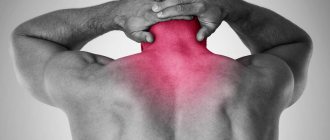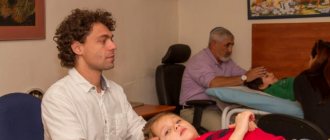Down's disease is a disease associated with an abnormal set of chromosomes, manifested by dementia, physical development disorders, congenital deformities and functional deficiency of the endocrine glands.
This is a common chromosomal disease: the prevalence among newborns is 0.15%, that is, 1 case in 650 children born. The pathology is not related to the sex of the child. Among patients with mental retardation (a form of dementia), 10% are people with Down syndrome (DS).
Causes
Back in 1959, it was established that the cause of Down's disease lies in a defect in the chromosome set and is associated with the number or structure of chromosomes. Most often (94%) a child has trisomy - an “extra” 21st pair of chromosomes.
This happens in cases where, for some reason, the 21st pair in the mother’s body does not separate, and an egg with 24 chromosomes matures.
When this egg is fertilized by a sperm with a normal set of chromosomes (23 chromosomes), an embryo with 47 chromosomes develops - the baby is born with b.D. This mechanism of chromosomal aberration occurs in women over 35 years of age.
Less often, in sick children (3-5%), the number of chromosomes does not increase - that is, there are 46 of them, but they have a translocation: an extra 21st chromosome is attached to the 13th, 15th or 22nd pairs. No clinical differences were found in patients with trisomy and chromosome translocation.
In some patients (3-4%) with b.D. mosaic trisomy is detected: that is, there are cells with a normal set of chromosomes, and along with them there are cells with an extra 21 chromosome. In this case, there are erased manifestations of the disease. Children with a mosaic karyotype are born to young women who are carriers of the translocation: their eggs have only 45 chromosomes. Chromosomal changes occurred in one of the ancestors.
The causes of chromosomal abnormalities have not been fully established. Babies with this pathology are born last among sisters and brothers. Both before and after the birth of a baby with b.D. Women often experience spontaneous miscarriages and stillbirths.
At the birth of fraternal twins b.D. is found in one of them, and at the birth of identical twins - in both twins.
Chromosomal aberrations can be caused by:
- stressful situations;
- starvation of a woman;
- ionizing radiation;
- exposure to chemical factors.
Pregnancy with chromosomal abnormalities occurs with toxicosis, its duration is less than normal; There is often a threat of miscarriage. Women often have an aggravated obstetric history (cases of stillbirth and miscarriages).
The risk of having a baby with b. D. increases sharply with a woman’s age (over 35 years), which is associated with the extra 21st chromosome in the egg. However, in 1/3 of cases, nondisjunction of 21 chromosome pairs occurs in the sperm and leads to the same pathology.
The connection between the birth of a sick baby and the age of the mother has been absolutely proven. Thus, out of 2000 pregnant women under the age of 25, only one child is born with BD, and at the age of 25 to 30 years – already 1 child per 1300 newborns. After 35 years, the risk increases by 3-4 times. By the age of 50, a pregnant woman has a genetic anomaly in every 8 children born.
Translocation of chromosome 21 to chromosome group D or G is a rare pathology, but it can lead to the rebirth of an affected child in this family and does not depend on the woman’s age.
Symptoms
Children with b.D. have a peculiar characteristic appearance:
- reduced head size with a sloping occiput (head circumference at birth less than 32 cm);
- slanting palpebral fissures (outer corners are higher than inner ones), convergent strabismus is often observed;
- widened flattened bridge of the nose;
- deformed, small, lower-lying ears;
- enlarged and thickened tongue with deep grooves and pronounced papillae;
- the mouth is half open, malocclusion (protruding lower jaw);
- high palate;
- depigmented spots along the periphery of the iris;
- shortened neck;
- a wide hand has a transverse fold in the palm on one or both hands, shortened fingers;
- the little finger is short, with one flexion fold (instead of two), can be crescent-shaped;
- the feet are wide with a large gap between the first and second toes.
The baby's weight at birth is reduced, muscle tone is reduced. There are three (instead of two normally) open fontanelles of large sizes, which later close later. Children are lagging behind in growth and development: they hold their head at 5-6 months, sit only at one year, and walk at 1.5-2 years. The timing and order of teething are also disrupted. At an early age, coordination of movements suffers, but in the process of development it, like muscle tone, can improve somewhat.
Speech develops with a significant delay: the baby pronounces the first words by 2 years, and sentences by about 4-5 years. Sometimes, until the age of 6, a child pronounces only individual words. Children practically do not speak coherent speech.
The mental disorder is characterized by dementia of the type oligophrenia at the level of debility or imbecility. In rare cases, idiocy develops. Characteristic is the underdevelopment of not only intelligence and thinking, but also violations of other mental functions: attention, perception, memory with relatively intact emotions and instincts.
Judgments are primitive, vocabulary is poor, abstract thinking is inaccessible, attention is unstable. However, mechanical memorization and imitation, and easy suggestibility may be well developed. Slow thinking. Some children can learn to read and write, but learning to count is difficult for them. In 10 years they can master the 4-grade curriculum.
Children with b.D. Usually obedient, good-natured and affectionate, although they may show signs of stubbornness, irritability and restlessness. Passivity and psychomotor slowness are much less common.
They absolutely cannot adapt to systematic work.
Sexual development is significantly delayed. The external genitalia are often underdeveloped. In isolated cases, the ability to bear children is possible. Many children have congenital malformations: heart defects in 30-40% (patent foramen ovale, ventricular septal defect), digestive organs (narrowing or fusion of the intestinal lumen, lengthening of the colon, etc.). Hernias (inguinal, umbilical) often develop.
There may be fusions of the fingers, deformation of the sternum, underdevelopment of the pelvic bones. The height is below average, the body is slightly tilted forward when walking. As the child grows, the voice becomes lower. The skin is dry and often flakes on the face. Due to endocrine disorders, there is a tendency to obesity.
Resistance to infections is significantly reduced. Infectious diseases are characterized by severity and can even lead to death. Conjunctivitis and blepharitis are often observed. Teeth affected by caries.
Predisposition to acute leukemia in 15 r. higher than other children. According to some scientists, in patients with acute leukemia there is also a connection with the appearance of an additional chromosome or with chromosome translocation. The development of leukemia is often the cause of death in children with b.D.
Down's disease - pathological anatomy
A morphological study of the nervous system of deceased patients is characterized by a decrease in the size and weight of the brain, underdevelopment of the frontal and other lobes, and poor differentiation of the sulci and convolutions of the brain. In some cases, abnormal development of the brain and large cerebral vessels occurs. Histologically, impaired differentiation of nerve cells and insufficient myelination of nerve fibers of the brain and spinal cord are revealed. Internal organs are reduced in size. Hypoplasia of the endocrine glands is observed, especially the thyroid gland, adrenal cortex and gonads. In the liver - fatty vacuolization, fibrosis. The aorta is narrow, its walls are thin, large vessels are of smaller diameter. Congenital defects of the heart, gastrointestinal tract and other organs are often observed.
Treatment
No specific treatment has been found. Modern medicine cannot cure this pathology.
The ongoing drug treatment, classes with a speech therapist in combination with massage and physical therapy somewhat improve the condition of the sick child.
In order to stimulate mental development, nootropics (Cerebrolysin, Ceraxon, Lipocerebrin, Aminalon), vitamin and restorative drugs, and glutamic acid are prescribed. If necessary, use thyroid-stimulating hormones (Thyroidin), anabolics (Nerobol, Methylandrostenediol, Dianabol). The medical and pedagogical work carried out is also important for the development of the child.
Prevention
Medical genetic counseling is important at the pregnancy planning stage.
Prevention of Down disease involves conducting a medical genetic consultation with parents in order to identify aberrations and translocations of chromosomes and determine the degree of risk of having a baby with BD.
When a child is born in a family with the translocation variant b.D. detection of a translocation in one of the parents indicates an increased risk of re-birth of a sick baby and the need for intrauterine diagnosis using amniocentesis.
With a translocation of chromosome 13/21 found in the father, the risk is 2.5%, and if in the mother, it is about 10%. If a translocation of type 21/21 is detected in one of the spouses, there is a risk of having a baby with b.D. is 100%.
It is advisable to carry out amniocentesis when a balanced translocation or mosaicism is detected in parents when the pregnant woman is over 35 years old.
At the birth of a baby with the trisomic form of b.D. the risk of having a sick child again depends on the woman’s age: up to 35 years – the risk is less than 1%, up to 40 years – 1%, 45 or more years – 3%. If mosaicism is detected in parents, the risk is 30%.
Diagnostics
An important role in detecting this chromosomal pathology is played by timely diagnosis, which is usually carried out during pregnancy using modern techniques and screenings.
Ultrasound
Is it possible to detect Down syndrome using ultrasound, and at what time? Yes, there are ultrasound signs (they are also called markers) of this genetic disorder. However, none of these ultrasound markers is a true and completely absolute symptom of Down syndrome. Additional studies are needed to confirm the diagnosis.
Genetic tests
They are offered to families in which the risk of having a baby with this syndrome is very high.
Invasive examinations
Not recommended for women over 34 years old. They require the insertion of various instruments into the uterus, which can lead to damage to its walls, the fetus itself, and even miscarriage.
- Amniocentesis is a puncture of the amniotic membrane for the purpose of laboratory examination of amniotic fluid.
- Chorionic villus biopsy - obtaining chorion tissue (the outer membrane of the embryo) to identify and prevent chromosomal pathology.
- Cordocentesis is the collection of fetal cord blood.
Non-invasive examinations
- Prenatal screening program
The results indicate the risk of having a child with Down syndrome, but do not 100% confirm the diagnosis. Two screenings are carried out - in the first and second semesters. They involve blood tests and ultrasound. A special test is prescribed for Down syndrome in pregnant women - hCG (chorionic gonadotropin - a substance secreted by the fetus). To donate blood, no special preparation (such as diet) is required. In the morning, on an empty stomach, blood is drawn from a vein.
- First trimester: a blood test for Down syndrome is prescribed before the 13th week. Result: hCG content is increased, PAPP-A (a special protein) is decreased. With such indicators, a chorion biopsy is performed.
- Second trimester: a blood test for Down syndrome provides material for the study of 4 elements, not two (hCG, estriol, AFP, inhibin-A).
If a high risk of Down syndrome has been determined by the first screening (1 in 500), additional invasive studies are prescribed in the early stages of pregnancy in order to make a timely decision. However, the result of a screening test, as practice shows, is not always accurate. There are often cases when both an ultrasound and a blood test confirm the diagnosis, but the parents, despite this, leave the baby alive, and he is born without genetic abnormalities. To avoid such errors, an innovative diagnostic technique was developed.
- Prenatal diagnosis of major trisomies
This is a new method that involves whole-genome sequencing of the karyotype, the fetal DNA that circulates freely in the maternal blood. This diagnosis is more reliable compared to invasive methods. The latter are accompanied by the mechanical work of geneticists, in which an error is made in 10% of cases. Non-invasive study of trisomy is performed using the latest generation sequencers using mathematical analysis. This guarantees a 99.9% correct result. The most common and well-proven methods:
- The very first non-invasive test based on taking blood from a vein from a pregnant woman is MaterniT21 PLUS.
- Tests from Verinata, Illumina, Ariosa Diagnostics and Natera (USA).
- DOT test (joint development of Russia and the USA).
- Chinese test for Down syndrome during pregnancy from the genetic company BGI.
So modern techniques make it possible to identify Down syndrome during pregnancy and help parents make a definite decision. Therefore, all analyzes and tests are prescribed in semesters I and II, since at week 20 it is too late: the child begins to move.
Today, the proportion of women who terminated pregnancy due to prenatal diagnosis of this pathology is about 92%. Perhaps it is influenced by the fact that such a diagnosis is made for life: the syndrome cannot be treated. Parents can only improve the living conditions of such a child.
Interesting fact. Many films have been made about people with Down syndrome that have received recognition and worldwide fame: “Temple Grandin”, “Me Too”, “People Like Us”.
Summary for parents
The birth of a baby with b.D. is associated with the presence of an extra or attached chromosome 21, although the reasons for such genetic changes are not fully known. For women over 35 years of age, the risk of having a sick baby is significantly higher.
To prevent the birth of a sick baby, there is a medical genetic consultation, where a study is carried out to determine the degree of risk. It is mandatory to conduct such counseling when a sick child is born into a family and when planning a second pregnancy.
Children with b.D. significantly retarded in development and have varying degrees of mental retardation. Only with the help of their parents can they learn practical skills and concepts. The environment plays a significant role in their development.
The child should be helped to develop motor skills and speech; speech therapists and speech therapists can help with this. Depending on the severity of the manifestations, it is possible for the sick child to adapt to existence in this world.
Course of the disease
Little can be said regarding the course of Down syndrome. Throughout their entire lives, patients remain in almost the same physical and mental state that they showed in early childhood, that is, the initial phenomena hardly change. There is no tendency towards progressive development. In general, children with Down syndrome die early (average life expectancy is about 50 years). Their lymphatic constitution causes increased susceptibility to tuberculosis, to which most patients fall victim.











